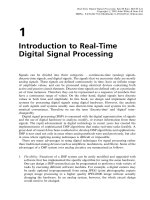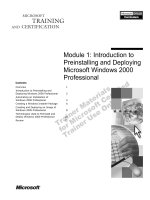Chapter 1: INTRODUCTION TO COMPUTER AND PROGRAMMING
Bạn đang xem bản rút gọn của tài liệu. Xem và tải ngay bản đầy đủ của tài liệu tại đây (1.56 MB, 33 trang )
Chapter 1
INTRODUCTION TO COMPUTER AND
PROGRAMMING
Programming Fundamentals
1
Chapter 1
Hardware and software
Programming Languages
Problem solution and software development
Algorithms
Programming Fundamentals
2
Computer Hardware
Input unit
Output unit
Memory unit
ALU
CPU
Secondary storage
Programming Fundamentals
3
Input Unit and Output Unit
Input Unit
- It obtains information from
various input devices and
places this information at the
disposal of the other units.
- Examples of input devices:
keyboards, mouse devices.
Output Unit
- It takes information that has been processed by the
computer and places it on various output devices.
- Most output from computer is displayed on screens, printed
on paper, or used to control other devices.
Programming Fundamentals
4
Input Unit and Output Unit
Programming Fundamentals
5
Memory Unit
The memory unit stores information. Each computer contains
memory of two main types: RAM and ROM.
RAM (random access
memory) is volatile. Your
program and data are stored
in RAM when you are using
the computer.
ROM (read only memory)
contains fundamental
instructions that cannot be lost
or changed by the user. ROM is
non-volatile.
Programming Fundamentals
6
ALU and CPU
Arithmetic and Logic Unit (ALU)
ALU performs all the arithmetic and logic
operations.
Ex: addition, subtraction, comparison, etc..
CPU
The unit supervises the overall
operation of the computer.
Programming Fundamentals
7
Secondary Storage
Secondary storage devices are
used to be permanent storage area for
programs and data.
Examples: magnetic tapes, magnetic disks
and optical storage CD.
Magnetic hard disk
Floppy disk
CD ROM
etc…
Programming Fundamentals
8
Some terminology
A computer program is a set of
instructions used to operate a
computer to produce a specific
result.
Writing computer programs is
called computer programming.
The languages used to create
computer programs are called
programming languages.
Software means a program or a
set of programs
Programming Fundamentals
9
Machine languages
Machine languages are the lowest
level of computer languages.
Programs written in machine
language consist of 1s and 0s.
Programs in machine language can control directly
to the computer’s hardware.
Example:
00101010 000000000001 000000000010
10011001 000000000010 000000000011
opcode
address parts
Programming Fundamentals
10
Machine languages (cont.)
A machine language instruction consists of two
parts: an instruction part and an address part.
The instruction part (opcode) tells the computer the
operation to be performed.
The address part specifies the
memory address of the data to be
used in the instruction.
00101010 000000000001 000000000010
opcode
address parts
Programming Fundamentals
11
Assembly languages
Assembly languages perform the same tasks as machine
languages, but use symbolic names for opcodes and operands
instead of 1s and 0s.
LOAD BASEPAY
ADD OVERPAY
STORE GROSSPAY
An assembly language program must be translated into a
machine language program before it can be executed on a
computer.
Programming Fundamentals
12
Assembler
Assembly
language
program
Translation
program
(assembler)
Programming Fundamentals
Machine
language
program
13
High-level Programming Languages
High level programming languages create computer
programs using instructions that much easier to
understand.
Programs in a high-level languages must be
translated into a low level language using a program
called a compiler.
A compiler translates programming
code into a low-level format.
Programming Fundamentals
14
High-level Programming Languages (cont.)
High-level languages allow programmers to write
instructions that look like every English sentences
and commonly-used mathematical notations.
Each line in a high-level language program is called
a statement.
Example:
Result = (First + Second)*Third
Programming Fundamentals
15
Application and System Software
Two types of computer programs are:
application software and system software.
Application software consists of those
programs written to perform particular
tasks required by the users.
System software is the collection
of programs that must be available
to any computer system for it to
operate.
Programming Fundamentals
16
Examples of system software
The most important system software is the operating
system.
MS-DOS, UNIX, MS WINDOWS, MS WINDOWS NT
Many operating systems allow
user to run multiple programs.
Such operating systems are
called multitasking systems.
Beside operating systems,
language translators are
system software.
Programming Fundamentals
17
PROGRAMMING LANGUAGES
Some well-known programming languages:
FORTRAN
COBOL
BASIC
PASCAL
C
C++
Java
1957
1960s
1960s
1971 Structure programming
Object-oriented programming
What is Syntax?
A programming language’s syntax is the set of rules for writing
correct language statements.
Programming Fundamentals
18
The C Programming Language
In the 1970s, at Bell Laboratories, Dennis Ritchie and Brian
Kernighan designed the C programming language.
C was used exclusively on UNIX and on mini-computers.
During the 1980s, C compilers were written for other platforms,
including PCs.
To provide a level of standardization for C language, in 1989,
ANSI created a standard version of C, called ANSI C.
One main benefit of C : it is much closer to assembly language
other than other high-level programming languages.
The programs written in C often run faster and more efficiently
than programs written in other high-level programming
language.
Programming Fundamentals
19
The C++ Programming Language
In 1985, at Bell Laboratories, Bjarne Stroutrup created C++
based on the C language. C++ is an extension of C that adds
object-oriented programming capabilities.
C++ is now the most popular programming language for writing
programs that run on Windows and Macintosh.
The standardized version of C++ is referred to as ANSI C++.
The ANSI standards also define run-time libraries, which
contains useful functions, variables, constants, and other
programming items that you can add to your programs.
The ANSI C++ run-time library is called Standard Template
Library or Standard C++ Library
Programming Fundamentals
20
Structured Programming
During 1960s, many large softwares encountered severe
difficulties. Software schedules were late, costs exceeded
budgets and finished products were unreliable.
People realized that software development was a far more
complex activity than they had imagined.
Research activity in the 1960s Structured Programming.
It is a discipline approach to writing programs that are clearer
than unstructured programs, easier to test and debug and
easier to modify.
Pascal (Niklaus Wirth) in 1971.
Pascal was designed for teaching structured programming in
academic environments and rapidly became the preferred
programming languages in most universities.
Programming Fundamentals
21
Object Oriented Programming
In the 1980s, there is another
revolution in the software
community: object- oriented programming.
Objects are reusable software components that
model items in the real world.
Software developers are discovering that: using a
modular, object-oriented design and implementation
approach can make software development much more
productive.
OOP refers to the creation of reusable software
objects that can be easily incorporated into another
program.
Programming Fundamentals
22
Object Oriented Programming (cont.)
An object is programming code and data that can be
treated as an individual unit or component.
Data refers to information contained within variables,
constants, or other types of storage structures. The
procedures associated with an object are referred as
functions or methods.
Variables that are associated with an object are
referred to as properties or attributes.
OOP allows programmers to use programming
objects that they have written themselves or that
have been written by others.
Programming Fundamentals
23
PROBLEM SOLUTION AND
SOFTWARE DEVELOPMENT
Software development consists of
three overlapping phases
- Development and Design
- Documentation
- Maintenance
Software engineering is concerned with creating
readable, efficient, reliable, and maintainable
programs and systems.
Programming Fundamentals
24
Phase I: Development and Design
The first phase consists of four steps:
1. Analyze the problem
Analyze the problem requirements to understand what the program
must do, what outputs are required and what inputs are needed.
2. Develop a Solution
We develop an algorithm to solve the problem.
Algorithm is a sequence of steps that describes how the data are to
be processed to produce the desired outputs.
3. Code the solution
This step consists of translating the algorithm into a
computer program using a programming language.
4. Test and correct the program
Programming Fundamentals
25









